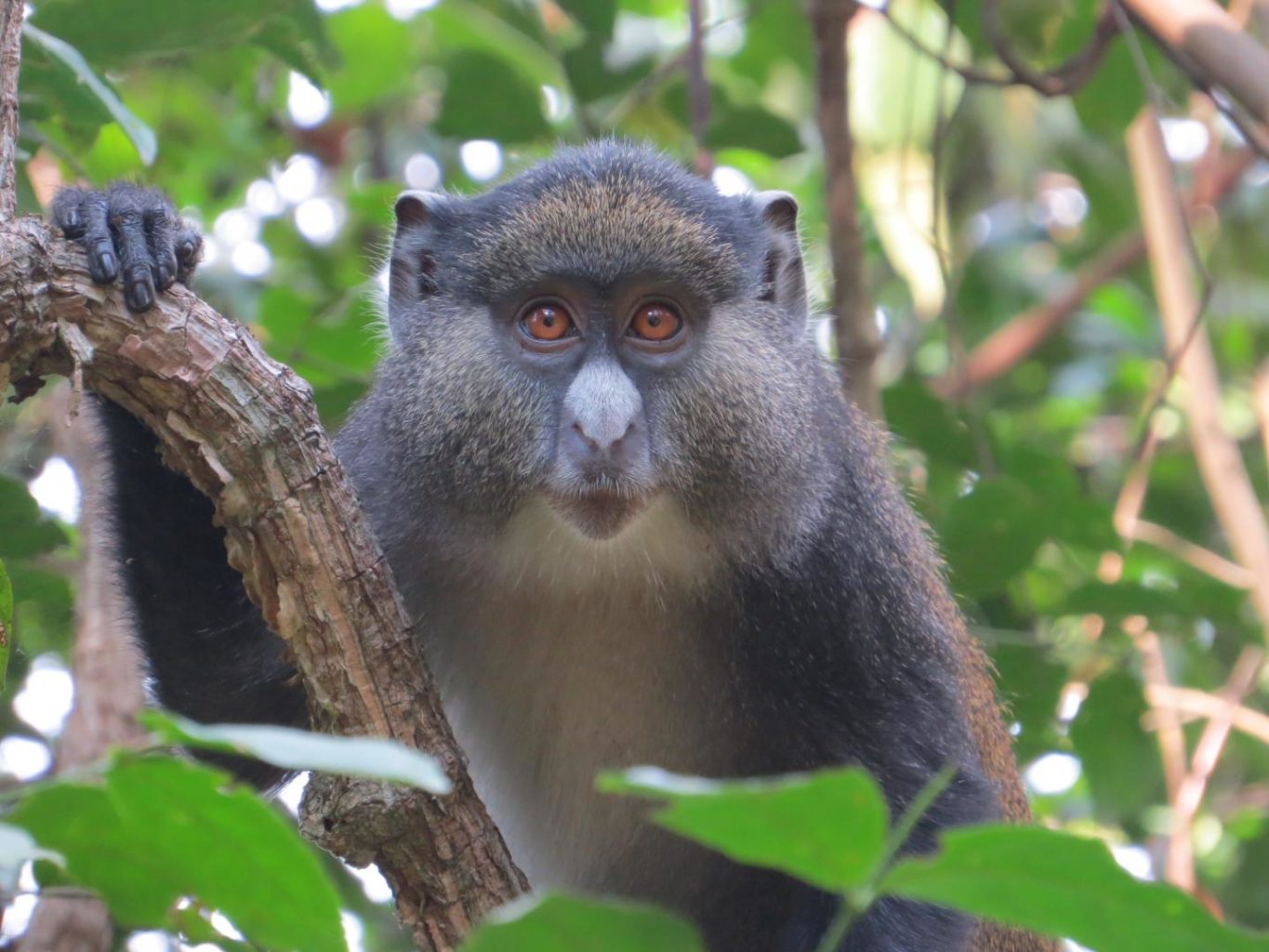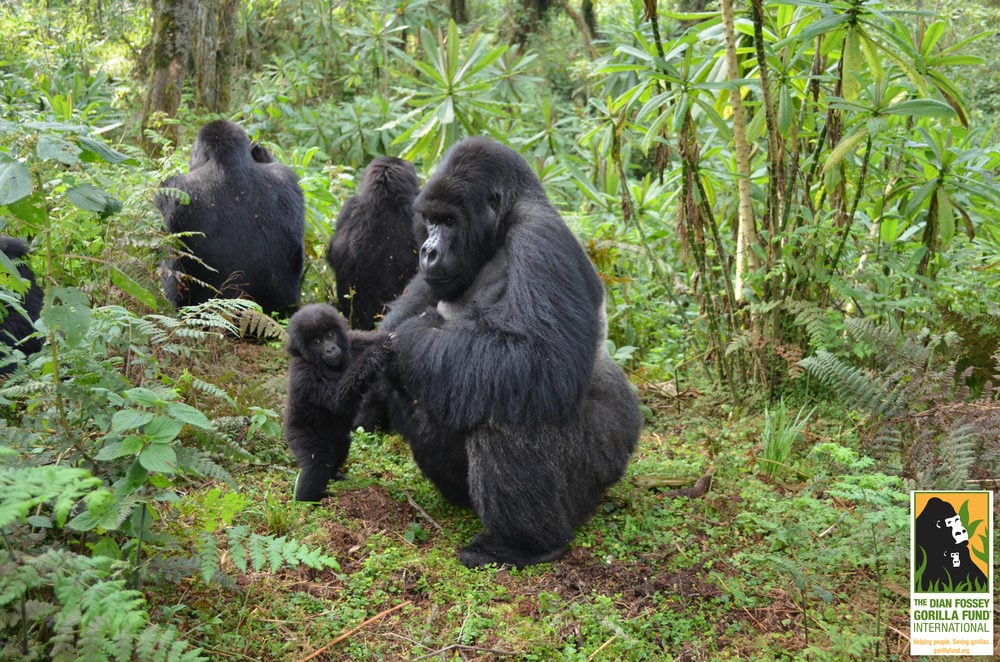Journal Article

“Jimmy” is a hybrid male monkey in Dr. Kate Detwiler’s study group in Gombe National Park. Photo credit: Manano Mpongo/ Gombe Hybrid Monkey Project
By Gisele Galoustian
Leakey Foundation grantee Kate Detwiler from Florida Atlantic University is the first to document that two genetically distinct species of guenon monkeys inhabiting Gombe National Park in Tanzania, Africa, have been successfully mating and producing hybrid offspring for hundreds maybe even thousands of years. Her secret weapon? Poop.
Prior studies and conventional wisdom have suggested that the physical characteristics of guenon monkeys with a variety of dazzling colors and very distinct facial features like bushy beards and huge nose spots are a function of keeping them from interbreeding. The idea is that their mate choices and the signals they use to select a mate are species specific and that they share common traits linked to their species.
So if their faces don’t match, they shouldn’t be mating, right? Wrong, according to evidence from a novel study published in the International Journal of Primatology.
For the study, Detwiler, who first studied these monkeys in Gombe National Park in 1994, examined the extent and pattern of genetic transfer or gene flow from “red-tailed” monkeys (Cercopithecus ascanius) to “blue” monkeys (Cercopithecus mitis) due to hybridization.
These two species are the only forest guenons that colonized the narrow riverine forests along Lake Tanganyika that characterize Gombe National Park. They co-exist in the same forests as Jane Goodall’s chimpanzees and baboons. Detwiler identifies hybrid monkeys by their combined markings from both parental species. She estimates that about 15 percent of this population is made up of hybrids, which is very unusual.

Kate Detwiler, Ph.D., lead author and an assistant professor in the Department of Anthropology in FAU’s Dorothy F. Schmidt College of Arts and Letters, who first studied these monkeys in 1994, collects fecal samples from monkeys in Gombe National Park. Photo credit: Amelia Villaseñor
Using mitochondrial DNA, extracted non-invasively from the feces of 144 red-tailed monkeys, blue monkeys, and hybrids, Detwiler is the first to show the movement of genetic material from one guenon species to another in an active hybrid zone. After examining the fecal samples, she found that all of the monkeys – hybrids, red-tails and blues have red-tailed mitochondrial DNA – all traced back to female red-tailed monkeys.
For this lineage of monkeys, it is the first time that science shows that not only is the DNA there, but so are the hybrids. Detwiler used mitochondrial DNA because it is more abundant than nuclear DNA in fecal samples, and only comes from the mother – indicating the maternal species in the hybridizing pair.
“There’s a lot of promiscuity taking place in Gombe National Park. Red-tails are mating with blues, blues are mating with red-tails, blues are mating with blues, red-tails are mating with red-tails, and hybrids are mating with everyone,” said Detwiler. “But we’re just not seeing any negative consequences from these two very different species repeatedly mating and producing offspring on an ongoing basis. If the differences in their facial features are so important and signal that they shouldn’t be mating, then why is this happening and why do I keep finding hybrid infants?”
A key finding from the study shows that the blue monkeys in Gombe National Park emerged out of the hybrid population, tracing their origins back to hybridization events between resident red-tails and blues most likely from outside the park. For her control groups, Detwiler collected and examined feces from blue monkeys from a park to the north and a park to the south where hybrids do not exist. These monkeys only had blue monkey mitochondrial DNA.
Detwiler speculates that red-tailed monkeys got to Gombe National Park first and thrived in the environment. Male blue monkeys outside the park had to find new homes after they were kicked out of their groups, which happens when they reach sexual maturity. Sex-driven, they ventured out into the landscape to find appropriate mates – female blue monkeys. Instead, they found the red-tailed females. Apparently, some female red-tailed monkeys were attracted to novel males with different faces and welcomed the sexual advances from these male blue monkeys.
“I keep coming back to the idea that if they are only supposed to mate with their own kind, then why did these red-tailed monkeys mate with the blue monkeys, especially if they had males of their own species around,” said Detwiler. “The female red-tailed monkeys present as willing partners and they are not coerced or forced into copulation with blue monkeys.”
Today, Gombe is an isolated forest habitat. Because they are very social and have had to share close quarters for decades or even centuries, Detwiler believes that they have socially learned that if you grow up in a hybrid group it is okay to mate with everyone.
“The Gombe hybrid population is extremely valuable because it can be used as a model system to better understand what hybridization looks like and how genetic material moves between species,” said Detwiler. “We have this amazing laboratory in nature to help us answer many questions about hybridization and how species boundaries are maintained. This research is very timely because hybridization often occurs in response to environmental changes, as we are seeing with climate change and modified landscapes — it is nature’s way to respond.”
This work was funded by a faculty research seed grant from FAU’s Division of Research, FAU’s Department of Anthropology, and doctoral dissertation research grants from the NSF (0424444), The Leakey Foundation, and the Wenner-Gren Foundation.
Video credit: Maneno Mpongo and Elizabeth Tapanes/Gombe Hybrid Monkey Project

